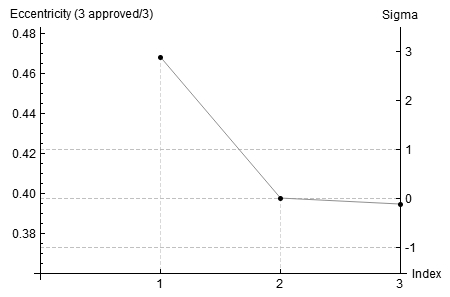The benefits of collecting extra data
I thought that an illustration was a good way to start this. This is a processed comparison between the 3 sets of data used in this section. I hope that you can see from left to right that the over all data has improved with the number of subs. Of course this is processed and each one separately, but it shows you that extra data can actually lead to processing gains as it does become easier to push some things further.
Just how many subs do we need? We know that extra subs continue to reduce noise, but often I have read that anything over 20 for example tends to lead to diminishing returns and so it's not worth adding more.
Here I have some data on the Cocoon nebula and I have three stacks of data consisting of the following.
Here I have some data on the Cocoon nebula and I have three stacks of data consisting of the following.
- 10x1800s in Ha
- 19x1800s in Ha
- 28x1800s in Ha
Noise
As you can see here, the noise has steadily decreased as each subsequent stack of data has been added. This will not be a linear improvement though, which can be seen with the shape of the graph. While there is a decrease in noise, the difference between 40-28.5 (12.5) when the first 9 extra subs were added is much more than the 22.5-28.5 (6) when the next 9 subs were added.
I am sure that there will be a cut off point, but I would suggest that based on this graph so far, it's more than 20 subs.
I am sure that there will be a cut off point, but I would suggest that based on this graph so far, it's more than 20 subs.
FWHM
I noticed this in some previous experimentation that I did - It seemed that the more subs in the stack decreased the FWHM figure. As we are always striving for tighter stars and sharper images then I am happy to take any gains that I can here.
Star eccentricity
Taking this to be general overall star roundness, it appears that perhaps at 28 subs I have reached as good as I can expect with this measurement. Any gains though are good in my book, but whether they are worth it generally beyond 20, this graph suggests not.
So ..... how many subs?
This hasn't really answered the question with a definitive answer, but I believe that in my case with my sky conditions etc that there are gains to be made beyond 20. I like to collect a lot of data so will definitely keep an eye on this over the coming few images and post any more thoughts or findings that I have.
I suppose that the key for me is experimentation for your own conditions. I'm not a self professed theory follower and so if I can personally show evidence for my circumstances that question the standard ideas then I am happy with that. Perhaps you may do the same and get very different results.
I suppose that the key for me is experimentation for your own conditions. I'm not a self professed theory follower and so if I can personally show evidence for my circumstances that question the standard ideas then I am happy with that. Perhaps you may do the same and get very different results.




